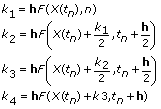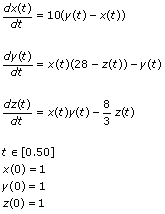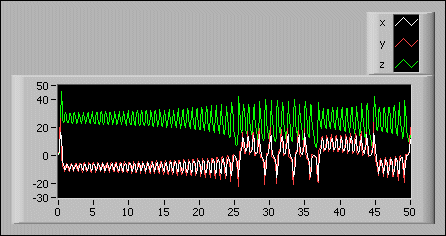 |
X is an array of strings of variables.
|
 |
time start is the start point of the ODE. The default is 0.
|
 |
time end is the end point of the time interval under investigation. The default is 1.0.
|
 |
h is the fixed step rate. The default is 0.1.
|
 |
X0 is the vector of the start condition x[10], …, x[n0]. There is a one-to-one relation between the components of X0 and X.
|
 |
time is the string denoting the time variable. The default variable is t.
|
 |
F(X,t) is a 1D array of strings representing the right sides of the differential equations. The formulas can contain any number of valid variables.
|
 |
Times is an array representing the time steps. The Runge Kutta method yields equidistant time steps between time start and time end.
|
 |
X Values is a 2D array of the solution vector x[10], …, x[n]. The top index runs over the time steps, as specified in the Times array, and the bottom index runs over the elements of x[10], …, x[n].
|
 |
ticks is the time in milliseconds for the whole calculation.
|
 |
error returns any error or warning from the VI. Errors are produced by using the wrong inputs X, X0, and F(X,t). You can wire error to the Error Cluster From Error Code VI to convert the error code or warning into an error cluster.
|
The Runge Kutta method of 4th order works with a higher degree of accuracy than the common Euler method and with a fixed step rate as a five stage process, more precisely
The following illustration shows the solution of the following system of ordinary differential equations:
Refer to the following VIs for examples of using the ODE Runge Kutta 4th Order VI:

 Add to the block diagram
Add to the block diagram Find on the palette
Find on the palette










 time end.
time end.


